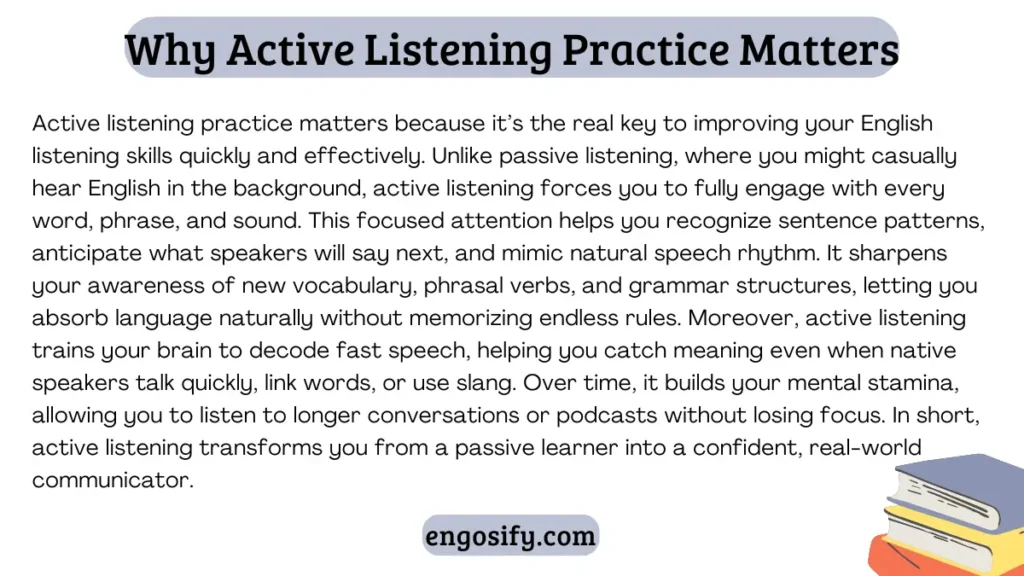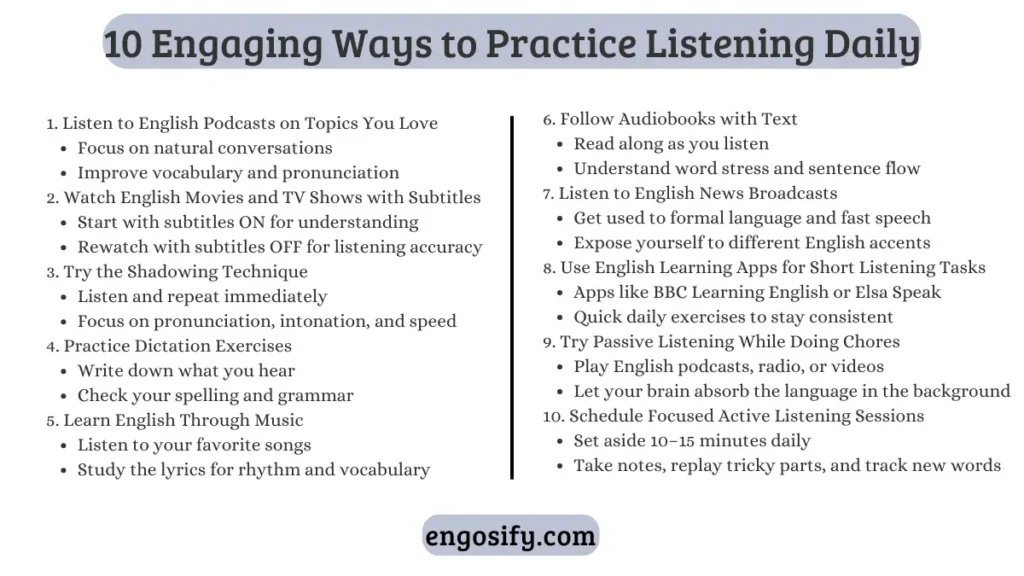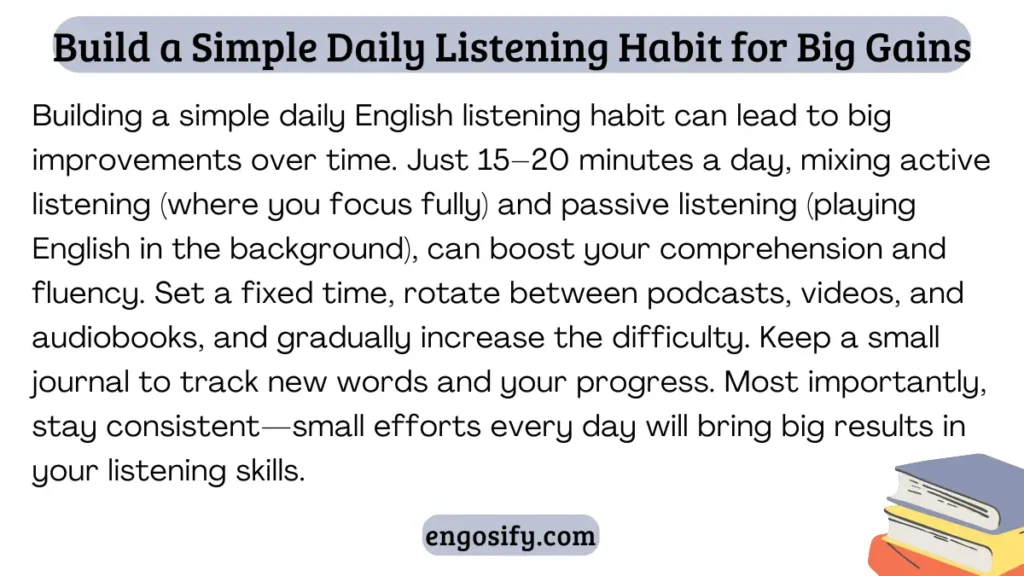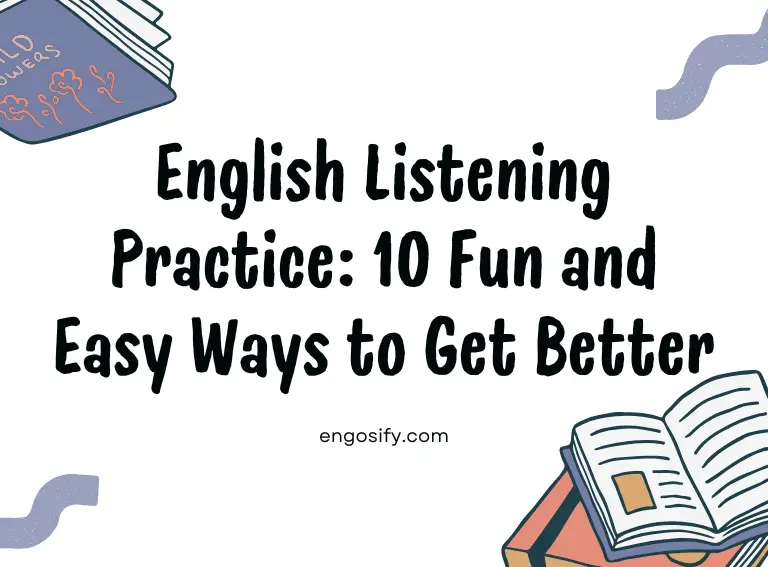Introduction – Unlock Your Listening Potential
Learning to understand spoken English can sometimes feel like chasing after a fast-moving train. Native speakers talk quickly, use slang, link words, and often mumble. Sound familiar? Don’t worry—you’re not alone!
If you’ve been struggling with English listening practice, this article is here to help. We’re not going to talk about boring textbook exercises or long grammar lectures. Instead, you’ll discover 10 fun and easy ways to sharpen your ears and boost your listening comprehension—fast!
Whether you’re preparing for exams like IELTS, improving your fluency for work, or just trying to catch more phrases in your favorite TV shows, these practical methods will fit right into your daily routine.
So, let’s jump in and explore why active listening (and not just passive exposure) is the real secret to getting better at English… starting today!
Why Active Listening Is the Shortcut to Fluency
Many learners think listening practice means putting on a podcast and letting it play in the background while doing other things. But here’s the truth: passive listening rarely works on its own.
Active listening—where you focus fully, interact with the content, and challenge your ears—brings faster and lasting results.
Benefits of Active Listening:
- It improves pronunciation recognition, making it easier to understand fast speakers.
- You’ll start catching new vocabulary, idioms, and natural expressions.
- It trains your brain to fill in missing words, even when the speaker talks quickly or with an accent.
- Plus, it builds your overall fluency and listening confidence.
As highlighted in the British Council listening practice, focusing on short, level-appropriate materials and gradually increasing difficulty is key to listening improvement.
Why Active Listening Practice Matters
When it comes to improving your English listening skills, many learners fall into the same trap: they think just hearing English every day is enough. But guess what? Passive listening alone won’t magically boost your understanding. You need active listening.
So, why is it so important? Let’s break it down.
Listening Builds Fluency Naturally
First things first, listening is directly connected to speaking fluency. The more you train your ears, the easier it becomes to respond quickly and naturally in conversations. You’ll start picking up on:
- Native pronunciation patterns
- Common vocabulary and phrases
- Real-life speaking speed
This makes your speaking sound more authentic and fluid.

It Sharpens Vocabulary and Grammar Recognition
Another big win? Vocabulary and grammar structures will stick better. When you hear phrases like “I’ve been working…” or “Could you pass me…” repeatedly, you’ll start using them yourself—without overthinking.
Listening also reinforces tricky grammar rules, especially things like:
- Verb tenses in conversation
- Question forms
- Conditional sentences
According to the Leonardo English listening activities, listening in context helps grammar flow naturally into your speech.
Real-World English Isn’t Textbook Perfect
Let’s be real—native speakers don’t talk like your English textbook.
- They mumble
- They use contractions
- They blend words together
Active listening gets your ears used to real-world English sounds. This makes understanding movies, YouTube videos, podcasts, and even street conversations much easier.
10 Engaging Ways to Practice Listening Daily
Tired of the same old listening exercises? Let’s shake things up! Below are 10 fun and easy ways to make your English listening practice enjoyable and super effective. You don’t need fancy tools or hours of study time—just consistency and creativity.
1. Podcast Idiom Hunter
Podcasts are goldmines for real spoken English. But here’s a twist: focus on hunting for idioms and phrasal verbs during your listening sessions.
How it works:
- Choose a podcast suited to your level (like The English We Speak from the BBC).
- Listen carefully and write down any unfamiliar idioms or expressions.
- Replay the section with the idiom, check its meaning, and use it in a sentence.
This technique boosts both listening comprehension and vocabulary recall.
2. The Subtitle Challenge
Sure, watching shows with subtitles feels easier—but let’s make it a challenge!
How it works:
- Watch an episode with subtitles ON first.
- Watch the same episode again with subtitles OFF.
- Focus on picking up key phrases and understanding speech rhythm.
This method is highly recommended in the Leonardo English listening activities for training your ears to catch words naturally.
3. News in Two Languages
Want to improve your listening and global awareness? Try this:
How it works:
- Watch or read the news in your native language.
- Immediately after, watch the same news story in English (BBC News or VOA Learning English works well).
Because you already know the story, your brain focuses on understanding the English version, making it easier to catch vocabulary and structure.
4. Dictation Practice
Dictation forces you to listen carefully and pick up every sound.
Steps:
- Choose a short audio clip (1–2 minutes).
- Listen line by line, pause, and write exactly what you hear.
- Check your answers using the transcript.
This sharpens your spelling, grammar recognition, and listening accuracy. The ESL Lounge beginner listening section offers free audio dictation exercises for practice.
5. Multiple Listening Passes
Listening once is never enough! Here’s a simple 3-step approach:
- First pass: Listen for the main idea.
- Second pass: Focus on specific details (names, dates, reasons).
- Third pass: Listen for new vocabulary and expressions.
This layered approach helps build both general understanding and detail recognition.

More Creative Listening Techniques to Boost Your Skills
Ready for more? Let’s dive into five more fun and practical listening methods that’ll help make your English listening practice both effective and enjoyable.
6. Cloze Listening Activities
This is a classic ESL method—but with a twist!
How it works:
- Take the transcript of a short dialogue or podcast episode.
- Delete key words (verbs, nouns, prepositions).
- Listen to the audio and try to fill in the blanks from memory.
This trains you to predict language patterns and focus on word recognition in context. Sites like the British Council listening practice offer free cloze exercises for learners at all levels.
7. Audiobooks and Music
Who said learning can’t be fun? Audiobooks and songs are fantastic tools for improving both listening comprehension and pronunciation awareness.
For audiobooks:
- Choose beginner-friendly books with simple language.
- Follow along with the written text as you listen.
For music:
- Pick English songs you love.
- Listen carefully to the lyrics, then check them online.
- Try singing along to improve intonation and word stress.
Both methods expose you to natural sentence rhythm and everyday vocabulary.
8. Media Immersion with Subtitles
Another great way to dive into real-life English is with media immersion—especially using subtitles wisely.
How to do it:
- Start with English subtitles ON for the first few episodes or videos.
- Once comfortable, watch similar content with subtitles OFF.
- Focus on lip movements, tone, and context clues.
Kids’ shows, YouTube vlogs, and TED Talks are perfect for this approach. Check out Leonardo English for more suggested resources for beginners.
9. Dictation and Pronunciation Apps
Technology makes listening practice easier than ever!
Try apps like:
- Speechling
- Elsa Speak
- BBC Learning English App
They allow you to:
- Listen to native speakers
- Record yourself
- Compare your pronunciation
- Improve word recognition and speech clarity
Using apps regularly keeps you engaged and tracks your progress.
10. Shadowing and Repeat-Aloud
Finally, let’s talk about the shadowing technique, a favorite among polyglots.
How it works:
- Play a short English audio clip (news, podcast, YouTube, etc.)
- Listen and repeat immediately after each sentence—copying tone, speed, and stress
- Don’t stop, even if you miss a word—just keep going
This powerful method helps you internalize natural speech patterns, improve fluency, and develop an English-speaking rhythm.
Best Tools and Resources for Effective Listening Practice
By now, you’ve got a toolkit full of fun listening techniques. But here’s the thing—without the right resources, even the best methods can fall flat. Let’s explore some reliable tools and platforms that can supercharge your English listening practice.
British Council LearnEnglish Listening Section
If you’re looking for structured listening exercises with graded difficulty, the British Council listening practice is a top pick.
Why it’s great:
- Levels range from A1 (Beginner) to C1 (Advanced)
- Includes audio clips, transcripts, and comprehension tasks
- Covers real-life situations and academic listening topics
Perfect for learners who want organized and level-appropriate practice.
Leonardo English Listening Activities
For those ready to level up, Leonardo English listening activities offer a wide range of podcast-style lessons.
Why learners love it:
- Focus on natural spoken English
- Covers interesting topics (history, culture, language learning tips)
- Transcripts and interactive exercises available
This platform is fantastic for making your listening sessions both educational and entertaining.
ESL Lounge – Student Listening Section
The ESL Lounge beginner listening section is perfect for absolute beginners who want to build confidence.
What it offers:
- Clear, slow-paced recordings
- Matching exercises and multiple-choice questions
- Different listening themes like travel, school, and shopping
If you’re just starting out, this is a safe and supportive platform to build your listening foundation.
Bonus: Apps for On-the-Go Practice
If you prefer mobile learning, try apps like:
- BBC Learning English App – Daily listening updates
- Elsa Speak – Focus on pronunciation and listening
- Quizlet – Great for vocabulary-based listening quizzes
Using a mix of these platforms ensures you get exposure to both formal and casual English listening styles.
Build a Simple Daily Listening Habit for Big Gains
Knowing effective listening techniques and having the right tools is only half the battle. The real secret? Consistency. Even just 15 to 20 minutes a day can create huge improvements in your English listening skills over time. Let’s build a simple yet powerful daily routine that fits easily into your life.
Set a Fixed Listening Time
First things first—schedule your practice. Choose a time when you’re relaxed and can focus, like:
- During your commute
- Right after breakfast
- Before bed
Creating a set routine makes listening practice as automatic as brushing your teeth.
Mix Active and Passive Listening
Balance both approaches to get the best results:
- Active Listening (at least 10 minutes):
Focus fully on the audio. Use techniques like dictation, shadowing, or cloze activities. Take notes on new phrases or difficult words. - Passive Listening (5–10 minutes):
Play English radio, podcasts, or TV shows in the background while doing light tasks. This helps your brain stay connected to English sounds without pressure.
Rotate Your Listening Materials
Avoid boredom by mixing different types of content:
- Podcasts on interesting topics
- Audiobooks or English songs
- YouTube channels for English learners
- News segments like BBC News or VOA Learning English
You’ll get used to different accents, speaking speeds, and content styles.
Track Your Progress
Keep a simple listening journal:
- Date
- What you listened to
- New words or phrases learned
- Difficulty level (easy/medium/hard)
Review your notes weekly to see your progress.
Also, as recommended in the British Council listening practice, increase the difficulty gradually. Move from beginner materials to more authentic native-level content as you improve.

Stay Consistent and Be Patient
Listening skills grow slowly but surely. Don’t get discouraged if you don’t understand everything at first. With daily practice, your ears will adjust, and soon you’ll catch more words, phrases, and even jokes you used to miss!
FAQs
How long does it take to improve English listening skills?
Improvement depends on how often and how actively you practice. If you commit to 15–30 minutes of focused listening daily, you’ll likely see progress within 4 to 6 weeks. The key is consistency and variety.
Is passive listening enough to get better?
In short, no. Passive listening, like playing English music in the background, can help your brain get familiar with the sounds of English. But to really improve, you need active listening techniques like dictation, shadowing, or transcription.
Should I always use transcripts while listening?
Not always. Transcripts are great for checking your understanding and learning new words. But it’s important to challenge yourself by listening without text first. Then, use the transcript later to fill in gaps and review mistakes.
Can I improve listening without talking to native speakers?
Absolutely! Thanks to podcasts, YouTube, audiobooks, and apps, you can immerse yourself in native-level content without needing face-to-face conversations. Tools like the British Council listening practice offer fantastic self-study resources.
Which is better for listening practice: podcasts or videos?
Both have benefits!
- Podcasts help you focus purely on sound without visual support—great for improving comprehension.
- Videos add visual cues like body language and facial expressions, making it easier to follow fast speech.
Mixing both gives you the best results for building your overall English listening fluency.
Conclusion
Improving your English listening skills doesn’t have to feel like a chore. With these 10 fun and easy techniques, you now have everything you need to make listening practice part of your daily life. Whether you choose podcasts, audiobooks, dictation, or the shadowing method, remember: consistency beats perfection.
So, start small, stay curious, and challenge your ears every day. Before you know it, you’ll be understanding more English conversations, songs, and shows with confidence. Pick two or three methods from this guide, set aside 15 minutes today, and watch your listening fluency grow.

